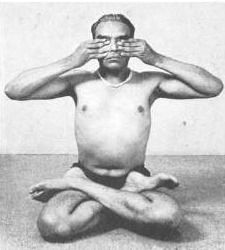Pratyahara - The 5th Limb
- Shining Waters
- Nov 13, 2017
- 4 min read

Pratyahara, the 5th of the 8 Limbs of Yoga is typically translated as "withdrawal of the senses". David Frawley describes it as, "fasting from the sensory impressions, but includes all methods of control of the senses and motor organs, and the internalization of attention." (Yoga & Ayurveda) In today's world we are constantly bombarded with external stimuli, making it increasingly difficult to focus our attention, to concentrate and be still. No wonder people have difficulty with meditation! Our attention has become limited and our monkey mind races from one thought or "To Do" list to another. We are easily distracted. Sometimes we are also distracted by pain, disease and ill health. All of these things inhibit our ability to be fully present. In many ways these external stimuli serve to keep us fractured and separate from our goals, and from the deeper Truth of our life. How many times have you reacted quickly to some outside stimulus out of anger or fear (such as traffic, or the news)...vs. taking time to be present, focus and react from a place of calm serenity. The same stimulus may arise, but you are better able to handle it from a place of calm. Yoga offers us tools to draw our sensory experience inward. Again, Frawley describes the specific practice and purpose of pratyhara, "It is not possible to move directly from asana (the physical forms of yoga) to meditation. This requires jumping from the body to the mind, forgetting what lies between. To make this transition, the breath and senses, which link the body and mind, must be brought under control and developed properly. This is where pranayama and pratyahara come in. With pranayama we control our vital energies and impulses and with pratyahara we gain mastery over the unruly senses - both prerequisites to successful meditation." One way to draw our senses inward is to simply close our sensory organs. This is why we typically close our eyes in meditation, or draw our gaze to one object, such as a candle flame, and focus on that object. Silence also helps to block out sound, or alternatively, we can use soothing music that functions as a sort of "white noise" and helps to block out extraneous sound. But this only works if the music is not distracting. This might also be simply the sound of ocean waves, or rustling leaves - anything that does not distract. If it is a distraction, it has the opposite effect of drawing your focus outward. Some people like to focus on the beating of their heart if they are able to sense it. Yet another way of practicing pratyahara is to simply eliminate negative impressions by turning off the television, computer and radio and taking a break for awhile. We can also replace negative impressions with positive ones by using techniques like visualization - imagining yourself in nature - or actually going out into nature, or to a temple, garden or other calm, serene place. These images and places offer respite for the mind away from noise and distraction. We can also create positive impressions by performing acts of selfless service. By performing "karma yoga" we create positive impressions within ourselves by creating joy or relief from suffering for others. Along with pratyahara, pranayama, or controlling the breath through a variety of techniques, is one of the simplest tools we can use to focus our attention, and everyone has access to it. By focusing our attention on our breathing, the mind has an anchor. For some, it may also be helpful to count the breath. "Inhale 1, Exhale 1, Inhale 2, Exhale 2," etc. This can be a useful tool to help us prepare for the more advanced practice of meditation. By eliminating negative impressions and cultivating positive ones, we are able to free the mind and focus on meditation and release. Practicing pratyahara can help to eliminate cravings - it can be a useful tool in treating addictions. It is also an important step in treating trauma, mental disorders and imbalances of the nervous system. Trauma originates from negative impressions - being physically or psychologically abused or from witnessing traumatic events. Replacing these negative impressions with positive impressions can be very healing. I want to caution here - that using pratyahara in this way should be done along with counseling, or under the care of a mental health professional. I'm not saying by practicing visualization and pranayama techniques alone without guidance one can make nightmares and the lasting scars of negative impressions go away. It's not that simple. It's a practice that should be guided under the care of a professional, and that, over time, can help heal wounds of the mind, and can also help to access the parasympathetic nervous system to allow the body/mind to access the relaxation response. Yoga Nidra is a pratyahara practice that aids in this healing and has been very successful in treating veterans with PTSD. In fact, the origins of the IRest program, developed by Richard Miller, are deeply tied to Yoga Nidra. In 2006, the Dept. of Defense conducted research at Walter Reed Army Medical Center on the efficacy of Yoga Nidra (an ancient meditative practice) in treating PTSD in soldiers returning from Iraq and Afghanistan. (For more on this: https://www.irest.us/projects/veterans ) If you are interested in learning more about the 5th limb of yoga - the practice of pratyahara - I invite you to join me for a workshop in Salisbury on December 8. This workshop on cultivating the 5th limb of yoga will include pranayama, mantra, mudra and visualization techniques, as well as restorative asana and will end with a short yoga nidra. See my event page for details: https://www.facebook.com/events/1914027692219338/ Or, contact me at kostanadancer@gmail.com. Namaste. (Photo is B.K.S. Iyengar demonstrating Shanmuki mudra).






























Comments